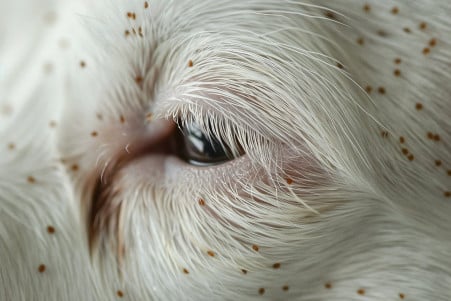Do Indoor Cats Get Fleas? How to Prevent Fleas in Your Home
17 May 2024 • Updated 16 May 2024

Even if your cat never goes outside, they can still be affected by the dreaded flea. Here's everything you need to know about fleas and how to keep your indoor cat safe. While outdoor cats are more likely to get fleas, indoor cats can still get fleas if they are brought in by people, other pets, or come in through cracks and crevices in the home, and if this happens, an infestation can occur.
However, don't worry too much. By referencing veterinary professionals and animal welfare groups, we can learn how indoor cats can get fleas, how to tell if your cat has fleas, and the best ways to get rid of these resilient pests and keep them from coming back. We'll also learn about the biology and behavior of fleas and the most effective methods for keeping your cat and home free of these pests.
Can indoor cats get fleas?
How Do Fleas Get Inside?
Fleas can be brought into the home on humans, clothing, or other pets, as Frontline points out. According to Elanco, fleas can also be introduced into the home via rodent infestations or nests near the house. Even an open door or window, or cracks in the foundation, can let fleas in.
Used furniture or secondhand items can also bring flea eggs or larvae into the home and lead to an infestation, says veterinarian Brian Evans in an interview with Daily Paws. Even cats living in high-rise apartments are at risk, as fleas can be brought in by visitors or come in on items from shared laundry facilities. Once a single flea is introduced into the home, it can quickly multiply and infest the space where your cat lives.
No home is safe from fleas, and it’s important to know the many ways they can be introduced into your home so you can take steps to protect your indoor cat. Even the most conscientious and clean pet owners need to be aware of these risks and take steps to prevent a flea infestation.
Common Symptoms: How to Know If Your Indoor Cat Has Fleas
Excessive scratching, licking, or biting at the skin can be a sign of fleas, according to PetMD. You may also notice small, dark specks (flea dirt) in the cat's fur or on their bedding, which is a sure sign of an infestation. Hair loss or scabs on the skin can also occur from the irritation of the bites, according to The Spruce Pets.
In more serious cases, anemia, lethargy, or pale gums can be caused by a flea infestation, according to the Cornell University College of Veterinary Medicine. If you think your indoor cat has fleas, it's important to see a vet for an accurate diagnosis and treatment because fleas can cause other health problems if they're not taken care of.
Knowing the symptoms of a flea infestation is the first step in making sure your indoor cat is safe and that your home stays flea-free. By keeping an eye out for symptoms and dealing with any problems as soon as they arise, you can make sure your cat is happy and healthy.
Flea-Borne Diseases: Risks for Indoor Cats
Flea bites can lead to severe itching, skin inflammation, and even hair loss in cats, according to FRONTLINE® Flea & Tick Protection. Some cats are hypersensitive to flea saliva and develop a condition called flea allergy dermatitis (FAD). Per BeChewy, FAD can cause the cat to scratch itself raw or develop scabs all over its body.
In addition to skin issues, heavy flea infestations can lead to anemia, especially in kittens and senior cats. Elanco notes that if a cat is bitten by enough fleas that feed on its blood, it can become anemic, which can cause the cat to become weak, lethargic, and breathe rapidly - a life-threatening situation.
Fleas can also transmit tapeworms and other parasites to cats when they're ingested, according to BeChewy. Meanwhile, flea-borne bacterial diseases like bartonellosis can be transmitted through flea bites and cause fever, lethargy, and swollen lymph nodes in cats.
Understanding the risks of flea-borne diseases for indoor cats is important for ensuring that you recognize the signs of infestations and protect your cat from potential health problems.
How to Get Rid of Fleas on an Indoor Cat
Your vet can recommend the best and safest flea treatments for your cat, according to WebMD. Some of the most popular treatments include topical spot-on treatments, oral medications, and flea collars, all of which contain active ingredients such as fipronil, imidacloprid, selamectin, and fluralaner.
In addition to these treatments, regular grooming with a flea comb can help get rid of adult fleas in your cat's fur, says PetMD. It's also important to make sure that you're vacuuming and cleaning your home thoroughly and washing your cat's bedding and any other fabrics they come into contact with in hot water to kill flea eggs, larvae, and pupae, according to The Wildest.
If you're dealing with a particularly bad flea infestation, you may also want to use a flea spray or powder in your home, but make sure to follow the directions on the product carefully, advises WebMD. Remember, the best way to get rid of fleas on your cat is to take a comprehensive approach that includes treating your cat and your home.
How to Prevent Fleas in Indoor Cats: Preventative Steps
All indoor cats should be on a year-round flea prevention medication, according to Vetster. The Companion Animal Parasite Council (CAPC) also states that maintaining a consistent schedule of veterinarian-approved flea prevention is the most effective way to prevent future infestations.
It's also important to regularly check your cat and your home for signs of fleas and to deal with any problems as soon as they arise. As mentioned by iTCH Pet, keeping a clean home by vacuuming and washing fabrics regularly can help get rid of potential flea eggs and larvae.
In addition, it's a good idea to limit your cat's exposure to potential sources of fleas, such as other animals or the outdoors. Petco recommends keeping your cat's living space clean and well-groomed to help prevent flea infestations.
Preventative care is the best way to avoid the health issues and treatment difficulties that come with fleas. By following these steps, you can make sure that your indoor cat stays healthy and free from fleas.
Final Takeaways: Preventing Fleas in Indoor Cats
As you can see, indoor cats can get fleas, even if they never go outside. It's important to know where fleas come from, what to look for, and what the potential health consequences are. Make sure to talk to your vet about the best ways to treat your cat for fleas.
Make sure to keep up with year-round flea prevention and keep your home clean. By staying on top of things, you can make sure your indoor cat never has to deal with a flea infestation.


